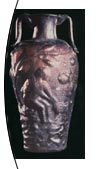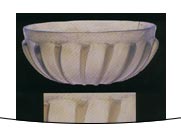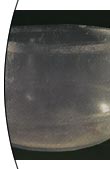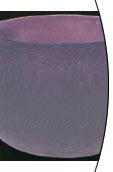Early Roman Imperial Period Glassware
The Catalogue
Early Roman Imperial Period Glassware
Alabastron
 Height:
11 cm, Diameter: 2 cm.
Height:
11 cm, Diameter: 2 cm.
Found in Yatağan, Yumurtalık.
Found in a tomb together with golden diadem pieces during road construction by
Turkish Coal Enterprises. Made either by the gold-banding glass technique or by
gold leaf mosaic technique, using various tones of partially transparent light
and dark blue-green glass ribbons, white opaque ribbons, and gold leaf. This
process involves either welding the glass pieces together inside a closed mold
by heating or shaping of glass by blowing or pressing. The upper part of the
alabastron is flat, the body is long and cylindrical-shaped, with a round
bottom. Colored ribbons trail the surface of the alabastron in a spiral pattern.
This kind of container is quite rare and very expensive; thus, it was only made
at selected production centres, such as Alexandria. There is weathering on the
surface.
Date: The Late Hellenistic – Early Roman Imperial Period, 1st century BC – 1st
century AD.
Similar Examples: P.Fossing, 1940, p.114-115, fig.87; S.Goldstein, 1976, p.207
fig.584: S.G.Platz Horster, 1976, p.26 fig.27; Y.Akat - N.Fıratlı, 1984, p.16,
fig.19, Pl.8.
 Amphoriscos
Amphoriscos
Height: 8cm, Diameter of Body: 4 cm.
Found in Stratonikeia in 1986.
Purple transparent glass, made by blowing into a two-sided mold. Has a round,
slightly in-folded rim, a short neck, a round shoulder, and a long cylindrical
body that narrows toward a flat bottom. There are tracings from the mold on both
sides. When blown inside a pre-fromed mold, the glass took the shape of the
relief decoration on the molds. The sailing ship relief on front side covers the
entire vertical surface. The main mast and yard mast of the sailing ship are
visible, as it is a mechanism for gathering in the sails on the main mast. One
end of the diagonally placed hawsers is tied to main mast and the other to the
sail. There are two figures in the sailboat; the prow and poop extensions are
visible and the oars are extended. The back of the oarsman is visible at one end
of the sailboat. There is a helmeted and armoured warrior of unusual dimensions
in the prow of sailboat; he has a shield in one hand and a sword in the other
hand. The Greek letters “Aias” ascend up the bottle from his left foot. Aias,
the son of Telamon, King of Salamis, is mentioned in Homer’s Iliad. The relief
field includes all of the front side from just below the shoulder to the base.
Waves of sea and a big fish are visible below the sailboat. There is a figure
with a lion or leopard pelt on his shoulder sitting under an olive-tree in the
relief on the other side of the amphoriscos. He is stretching his hand out to an
animal having a large head. This figure is probably Aias, who goes mad during
the Trojan War, attacking animals and finally killing himself. The olive-tree
behind Aias, with its leaves and olives, symbolized Athena. There are some
blue-colored marks on the body of the vase and around the shoulder. One broken
handle has been glued in place.
Date: The Early Imperial Period, 1st century AD.
Publications: Aynur Özet, 1993, p.142-145; Aynur Özet, 1995, p.4-8.
Similar Examples: Giovanni Mariacher, 1970, p.18, fig.4; Susan Matheson, 1980,
p.49-50, fig.127; JGS 5, 1963, p.141 no.3.
Ribbed Bowl
 Height:
6.4 cm, Diameter of Rim: 14.7 cm.
Height:
6.4 cm, Diameter of Rim: 14.7 cm.
Found in Marmaris.
Amber-colored transparent glass, made by pressing inside a closed mold.
Wheel-cutting ornamentation and polishing were done. There are some air bubbles
in the glass. Has a simple round rim, a convex body, and a flattened bottom.
There are 16 thick ribs encircling the exterior. They start just below the plain
rim and taper down to the bottom, ending in a radial shape. The interior of the
bowl has wheel-cutting line ornamentation. It is in the class of broad, shallow
bowls with long, thick ribs. After it was removed from the mold, it was
polished. There is weathering on the exterior surface.
Date: The Early Roman Imperial Period, 1st century AD.
Publication: A.Özet, 1992, p.115-133 fig.3.
Similar Examples: S.Goldstein, 1979, p.153, fig. 327, pl.20; G.Platz-Horster,
1976, p.22, fig.20; C.Isings, 1957, p.18, form.3; Norbert Kunisch, 1967, p.182,
4R4; I.Canav, 1985, p.85, fig.137; M.Stern, 1989, p.597; C.Lightfoot, 1992,
p.35, fig.4; Beat Rutti, 1991, p.20-185, Pl.18.
 Bowl
Bowl
Height: 5.7 cm, Diameter of Rim: 7.5 cm, Diameter of Belly: 8 cm.
Found in Köyceğiz.
Green transparent glass, made by free-blowing technique, cut by lathe and
polished. Has a round rim, cylindrical body and round bottom that has been
pressed upwards in the middle. There are two lathe-cut vertical grooves just
below the rim and on the lower part of the body. There are two wheel-cutting
line decorations between the two grooves. There are a few air bubbles in the
glass.
Date: The Early Roman Imperial Period, 1st century AD.
Similar Examples: Ş.Atik, 1980, p.17, fig.5; C.Lightfoot, 1989, p.77 fig.11,
form.1-2, pl.2-2 and p.73-77, fig.12; C.Lightfoot, 1991, p.93, fig.1/8;
Vanderhoeven, 1961, p.18, fig.14-15; A.von Saldern, 1980, p.13, pl. 2-57;
C.Isings, 1957, p.27, form.12; Beat Rutti, 1991, p.51.1047, pl.47-48, form AR
34.
Purple Bowl
 Height:
6.9 cm, Diameter of Rim: 8 cm.
Height:
6.9 cm, Diameter of Rim: 8 cm.
Found in Kaunos in 1974.
Excavation inventory number 70-54.
Purple, partially transparent glass, made by free-blowing technique, unpolished.
Has a slightly flaring straight rim, bi-conical body and simple flattened
bottom. Very thin wheel-cutting grooves encircle the body below rim. The rim
edge was rounded by firing. Exterior surface is rough. There is also weathering
on surface.
Date: The Early Imperial Period, 1st century AD.
Similar Examples: C.Lightfoot, 1992, p.67, fig.26; G.Platz-Horster, 1976, p.29;
M.Eskioğlu, 1989, p.189; Beat Rutti, 1991, p.35, pl.32, p.750 form AR 9.2:
Pliny, Naturalis Historia 136, describes dull red glass as blood glass. Large
amounts of copper and lead were seen in glass found in Pompeii in 1844. These
kinds of vessels, which were used as table and kitchen ware, funeral gifts, and
lamp, were produced during the entire Roman Imperial Period.